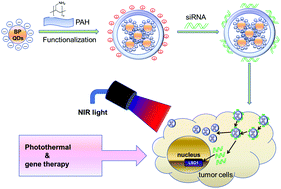As a novel semiconducting material, the inherent, direct, and appreciable band gap endows BP with preferable optical and electronic properties other than graphene and transition metal dichalcogenides. In addition, bio-related applications with equal importance also attract great attention thanks to several inherited advantages of BP including large drug loading capacity, high PDT efficiency, high biocompatibility and degradability. However, to date there is limited research about the biomedical applications of BP. In this study, we reported the engineering of polyelectrolyte polymers coated BP quantum dots (BP-QDs)-based nanocarriers to deliver small interfering RNA (siRNA) into human ovarian teratocarcinoma PA-1 cells. Compared to the commercial delivery reagents, superior transfection efficiency of BP-QD was detected. The expression of the LSD1 (lysine-specific demethylase 1) mRNA in PA-1 cells was significantly suppressed by BP-QDs-LSD1 siRNA complex. Notably, BP-QDs possess excellent biocompatibility and low cytotoxicity even at concentrations as high as 5 mg mL1. The combination treatment of BP nanodots-LSD1 siRNA complex with NIR light could inhibit the cell growth rate by more than 80%. In conclusion, this is the first application of BP-QDs as gene delivery systems, which shows promising potential for siRNA delivery and photothermal effects in cancer therapy.
Link: http://pubs.rsc.org/en/content/articlepdf/2017/tb/c7tb01068k
